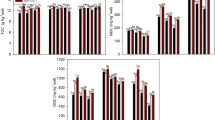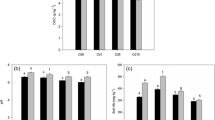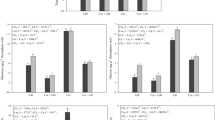Abstract
Aims
Sugars in soils play vital roles in soil aggregation and microbial activity, which is easily affected by environmental factors. Here, we investigated the accumulation of total sugars and monosaccharides in the rhizosphere soil of black locust seedlings exposed to the contamination of elevated atmospheric CO2 (eCO2) and cadmium (Cd) and its driving factors.
Results
Under eCO2 + Cd compared to Cd, glucose, galactose, arabinose, mannose, and xylose concentrations in the rhizosphere soil increased and the increases were significant at 4.5 mg Cd kg−1 (p < 0.05). Glucose was the most abundant sugar. The GM/AX ratio increased (p < 0.05) under eCO2 + Cd relative to Cd, suggesting that sugars in rhizosphere soils might be mainly from microbial synthesis under eCO2 + Cd. In addition, CO2, Cd, and CO2 + Cd influenced (p < 0.05) total sugar and monosaccharide concentrations and the (galactose + mannose)/(arabinose + xylose) (GM/AX) ratio. Sugars concentrations in rhizosphere soils were affected (p < 0.05) by responses of leaf and root biomass, Cd in roots, S in leaves, leaf C/N ratio, and pH and C in rhizosphere soils to eCO2. However, the contribution of sugars in the roots to those in rhizosphere soils was not significant under elevated CO2 + Cd exposure.
Conclusions
Elevated CO2 stimulated sugar concentrations in the rhizosphere soil of black locusts exposed to Cd, which was helpful to understand the contribution of global change scenarios to sugar accumulation in the rhizosphere of plants grown in heavy metal-contaminated soils.



Similar content being viewed by others
References
Bergmeyer HU (1974) Methods of enzymatic analysis, vol 3. Academic, New York, pp 212–1215
Blagodatskaya E, Khomyakov N, Myachina O, Bogomolova I, Blagodatsky S, Kuzyakov Y (2014) Microbial interactions affect sources of priming induced by cellulose. Soil Biol Biochem 74:39–49
Bongiovanni MD, Lobartini JC (2006) Particulate organic matter, carbohydrate, humic acid contents in soil macro- and microaggregates as affected by cultivation. Geoderma 136:660–665
Caldeira K, Wickett ME (2005) Ocean model predictions of chemistry changes from carbon dioxide emissions to the atmosphere and ocean. J Geophys Res 110:C09S04
Calfapietra C, Gielen B, Galema ANJ, Lukac M, Angelis P, Moscatelli MC, Ceulemans R, Scarascia-Mugnozza G (2003) Free-air CO2 enrichment (FACE) enhances biomass production in a short-rotation poplar plantation. Tree Physiol 23:805–814
Cheshire MV, Christensen BT, Sorensen LH (2010) Labeled and native sugars in particle-size fractions from soils incubated with 14Cstraw for 6 to 18 years. Eur J Soil Sci 41:29–39
Derrien D, Marol C, Balesdent J (2004) The dynamics of neutral sugars in the rhizosphere of wheat. An approach by C-13 pulse-labeling and GC/C/IRMS. Plant Soil 267:243–253
Ekmekçi Y, Tanyolaç D, Ayhan B (2008) Effects of cadmium on antioxidant enzyme and photosynthetic activities in leaves of two maize cultivars. J Plant Physiol 165:600–611
Fischer H, Meyer A, Fischer K, Kuzyakov Y (2007) Carbohydrate and amino acid composition of dissolved organic matter leached from soil. Soil Biol Biochem 39:2926–2935
Gattuso JP, Gao KS, Lee K, Rost B, Schulz KG (2010) Approaches and tools to manipulate the carbonate chemistry. In: Riebesell U, Fabry VJ, Hansson L, Gattuso J-P (eds) Guide to Best Practices for Ocean Acidification Research and Data Reporting. Publications Office of the European Union, Luxembourg, pp 41–52
Grandy AS, Erich MS, Porter GA (2000) Suitability of the anthrone-sulfuric acid reagent for determining water soluble carbohydrates in soil water extracts. Soil Biol Biochem 32:725–727
Grayston SJ, Campbell CD (1996) Functional biodiversity of microbial communities in the rhizospheres of hybrid larch (Larix eurolepis) and Sitka spruce (Picea sitchensis). Tree Physiol 16:1031–1038
Guggenberger G, Christensen BT, Zech W (1994) Land use effects on the composition of organic matter in particle-size separates of soils: I. Lignin and carbohydrate signature. Eur J Soil Sci 45:449–458
Gunina A, Kuzyakov Y (2015) Sugars in soil and sweets for microorganisms: review of origin, content, composition and fate. Soil Biol Biochem 90:87–100
Hishi T, Hirobe M, Tateno R, Takeda H (2004) Spatial and temporal patterns of water-extractable organic carbon (WEOC) of surface mineral soil in a cool temperate forest ecosystem. Soil Biol Biochem 36:1731–1737
Huang SP, Jia X, Zhao YH, Bai B, Chang YF (2017) Elevated CO2 benefits the soil microenvironment in the rhizosphere of Robinia pseudoacacia L. seedlings in Cd- and Pb-contaminated soils. Chemosphere 168:606–616
Hutsch BW, Augustin J, Merbach W (2002) Plant rhizodeposition – an important source for carbon turnover in soils. J Plant Nutr Soil Sci 165:397–407
IPCC (2014) Climate Change 2014: Synthesis Report. Contribution of working Groups I, II and III to the fifth assessment report of the intergovernmental panel on climate change [Core Writing Team, Pachauri RK, Meyer LA (eds)]. IPCC, Geneva, pp 151
Jia X, Gao YF, Li XD, Zhao YH, Wang L, Zhang CY (2021) Effects of cadmium on soil nitrification in the rhizosphere of Robinia pseudoacacia L. seedlings under elevated atmospheric CO2 scenarios. Sci Total Environ 772:145023. https://doi.org/10.1016/j.scitotenv.2021.145023
Jia X, Wang WK, Chen ZH, He YH, Liu JX (2014) Concentrations of secondary metabolites in tissues and root exudates of wheat seedlings changed under elevated atmospheric CO2 and cadmium-contaminated soils. Environ Exp Bot 107:134–143
Jia X, Zhao YH, Liu T, Huang SP (2016) Elevated CO2 affects secondary metabolites in Robinia pseudoacacia L. seedlings in Cd– and Pb–contaminated soils. Chemosphere 160:199–207
Jin CW, Du ST, Chen WW, Li GX, Zhang YS, Zheng SJ (2009) Elevated carbon dioxide improves plant iron nutrition through enhancing the iron-deficiency-induced responses under iron-limited conditions in tomato. Plant Physiol 150:272–280
Johnson RM, Pregitzer KS (2007) Concentration of sugars, phenolic acids, and amino acids in forest soils exposed to elevated atmospheric CO2 and O3. Soil Biol Biochem 39:3159–3166
Jones DL, Darrah PR (1996) Re-sorption of organic compounds by roots of Zea mays L. and its consequences in the rhizosphere. III: characteristics of sugar influx and efflux. Plant Soil 178:153–160
Kim S, Kang H (2011) Effects of elevated CO2 and Pb on phytoextraction and enzyme activity. Water Air Soil Poll 219:365–375
King JS, Hanson PJ, Bernhardt E, Deangelis P, Norby RJ, Pregitzer KS (2004) A multiyear synthesis of soil respiration responses to elevated atmospheric CO2 from four forest FACE experiments. Global Change Biol 10:1027–1042
Kraffczyk I, Trolldenier G, Beringer H (1984) Soluble root exudates of maize: in fluence of potassium supply and rhizosphere microorganisms. Soil Biol Biochem 16:315–322
Kuzyakov Y (2010) Priming effects: interactions between living and dead organic matter. Soil Biol Biochem 42:1363–1371
Kuzyakov Y, Domanski G (2000) Carbon input by plants into the soil. Review. J Plant Nutr Soil Sci 163:421–431
Lynch JM, Whipps JM (1990) Substrate flow in the rhizosphere. Plant Soil 129:1–10
Norby RJ (1994) Issues and perspectives for investigating root responses to elevated atmospheric carbon dioxide. Plant Soil 165:9–20
Oades JM (1984) Soil organic matter and structural stability: mechanisms and implications for management. Plant Soil 76:319–337
Pan X, Song W, Zhang D (2010) Earthworms (Eisenia foetida, Savigny) mucus as complexing ligand for imidacloprid. Biol Fert Soils 46:845–850
Pérez-de-Mora A, Burgos P, Madejón E, Cabrera F, Jaeckel P, Schloter M (2006) Microbial community structure and function in a soil contaminated by heavy metals: effects of plant growth and different amendments. Soil Biol Biochem 38:327–341
Suslov MA (2020) Dynamics of intercellular water transfer in the roots of intact Zea mays L. plants under elevated concentrations of atmospheric CO2. Plant Physiol Bioch 151:516–525
Tanaka H, Hamada R, Kondoh A, Sakagami K (1990) Determination of component sugars in soil organic matter by HPLC. Zentralbl Mikrobiol 145:621–628
Tian L, Dell E, Shi W (2010) Chemical composition of dissolved organic matter in agroecosystems: correlations with soil enzyme activity and carbon and nitrogen mineralization. Appl Soil Ecol 46:426–435
Vu JCV, Gesch RW, Pennanen AH, Allen LHJ, Boote KJ, Bowes G (2001) Soybean photosysnthesis, Rubisco, and carbohydrate enzymes function at supraoptimal temperatures in elevated CO2. J Plant Physiol 158:295–307
Wang L, Jia X, Zhao YH, Zhang CY, Gao YF, Li XD, Cao KM, Zhang NJ (2021) Effects of elevated CO2 on arbuscular mycorrhizal fungi associated with Robinia pseudoacacia L. grown in cadmium-contaminated soils. Sci Total Environ 768:144453. https://doi.org/10.1016/j.scitotenv.2020.144453
Warembourg FR, Estelrich HD (2000) Towards a better understanding of carbon flow in the rhizosphere: a time-dependent approach using carbon-14. Biol Fert Soils 30:528–534
Xu WH, Huang H, Wang AH, Xiong ZT, Wang ZY (2006) Advance in studies on activation of heavy metal by root exudates and mechanism. Ecol Environ 15:184–189 (in Chinese)
Yang YR, Song YY, Scheller HV, Ghosh A, Ban YH, Chen H, Tang M (2015) Community structure of arbuscular mycorrhizal fungi associated with Robinia pseudoacacia in uncontaminated and heavy metal contaminated soils. Soil Biol Biochem 86:146–158
Zak DR, Pregitzer KS, King JS, Holmes WE (2000) Elevated atmospheric CO2, fine roots and the response of soil microorganisms: a review and hypothesis. New Phytol 147:201–222
Zhang CY, Jia X, Zhao YH, Wang L, Cao KM, Zhang NJ, Gao YF, Wang ZW (2021) The combined effects of elevated atmospheric CO2 and cadmium exposure on flavonoids in the leaves of Robinia pseudoacacia L seedlings. Ecotox Environ Safe 210:111878. https://doi.org/10.1016/j.ecoenv.2020.111878
Acknowledgements
This work was jointly supported by the National Natural Science Foundation of China (grant Nos. 31870582 and 31270665) and the Project Supported by Shaanxi Key Laboratory of Land Consolidation of China (Program No. 2019TD-01).
Author information
Authors and Affiliations
Corresponding author
Additional information
Responsible Editor: Juan Barcelo.
Publisher's note
Springer Nature remains neutral with regard to jurisdictional claims in published maps and institutional affiliations.
Supplementary Information
Below is the link to the electronic supplementary material.
Rights and permissions
About this article
Cite this article
Jia, X., Zhao, J., Zhang, N. et al. Elevated atmospheric CO2 generally improved soluble sugars content in the rhizosphere soil of black locust seedlings under cadmium exposure. Plant Soil 468, 197–209 (2021). https://doi.org/10.1007/s11104-021-05129-y
Received:
Accepted:
Published:
Issue Date:
DOI: https://doi.org/10.1007/s11104-021-05129-y




